Improving internal control system of wood processing firms in Binh Dinh
Abstract
This paper focuses on analyzing five components of internal control system: Control
environment, Risk assessment, Control activities, Information and communications,
Monitoring and two cycles: Expenditure cycle, Revenue cycle at the wood processing firms
in Binh Dinh province. Based on the results of the situation, proposing some solutions and
recommendations to improve the internal control system of these firms.
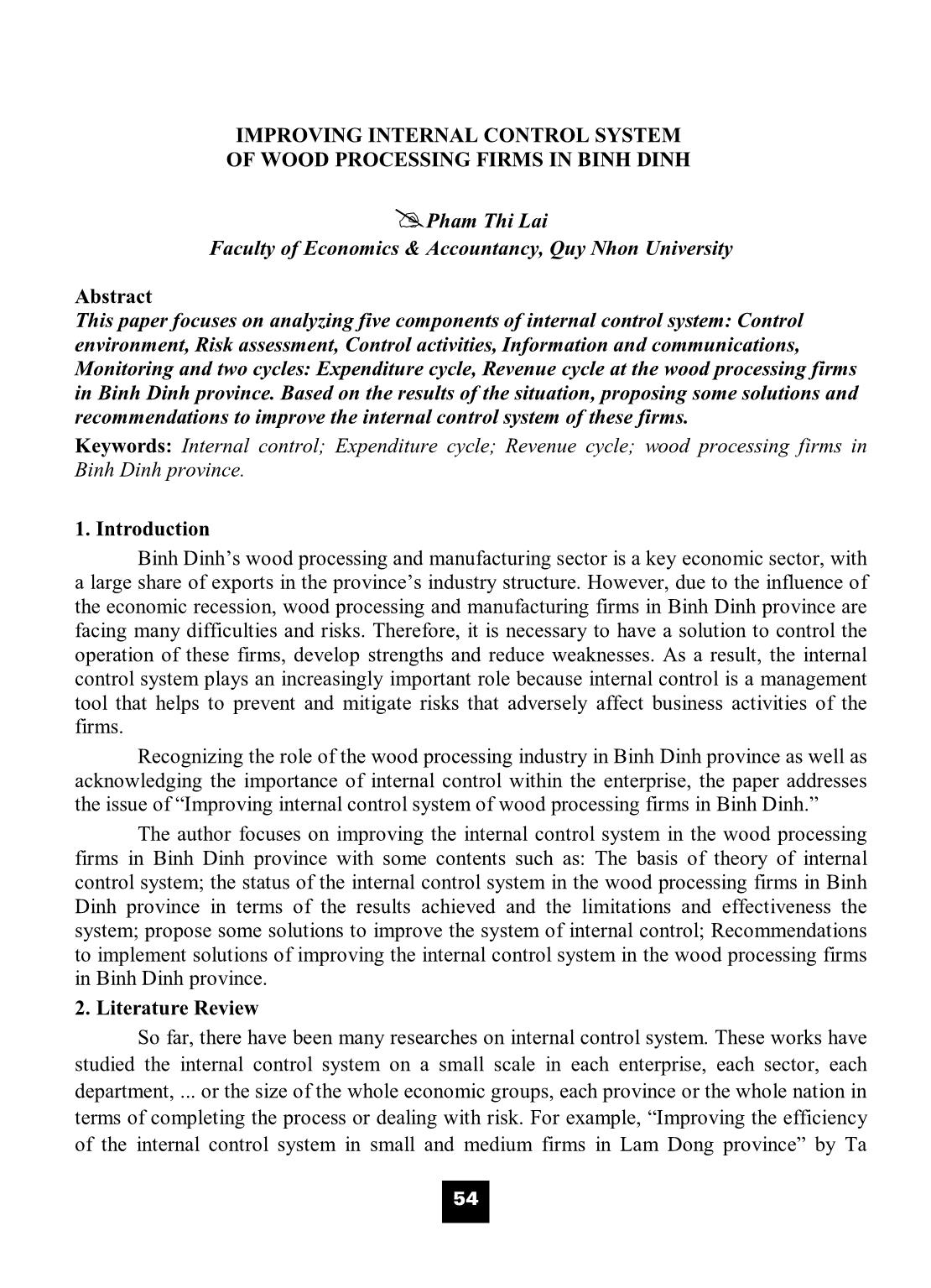
Trang 1
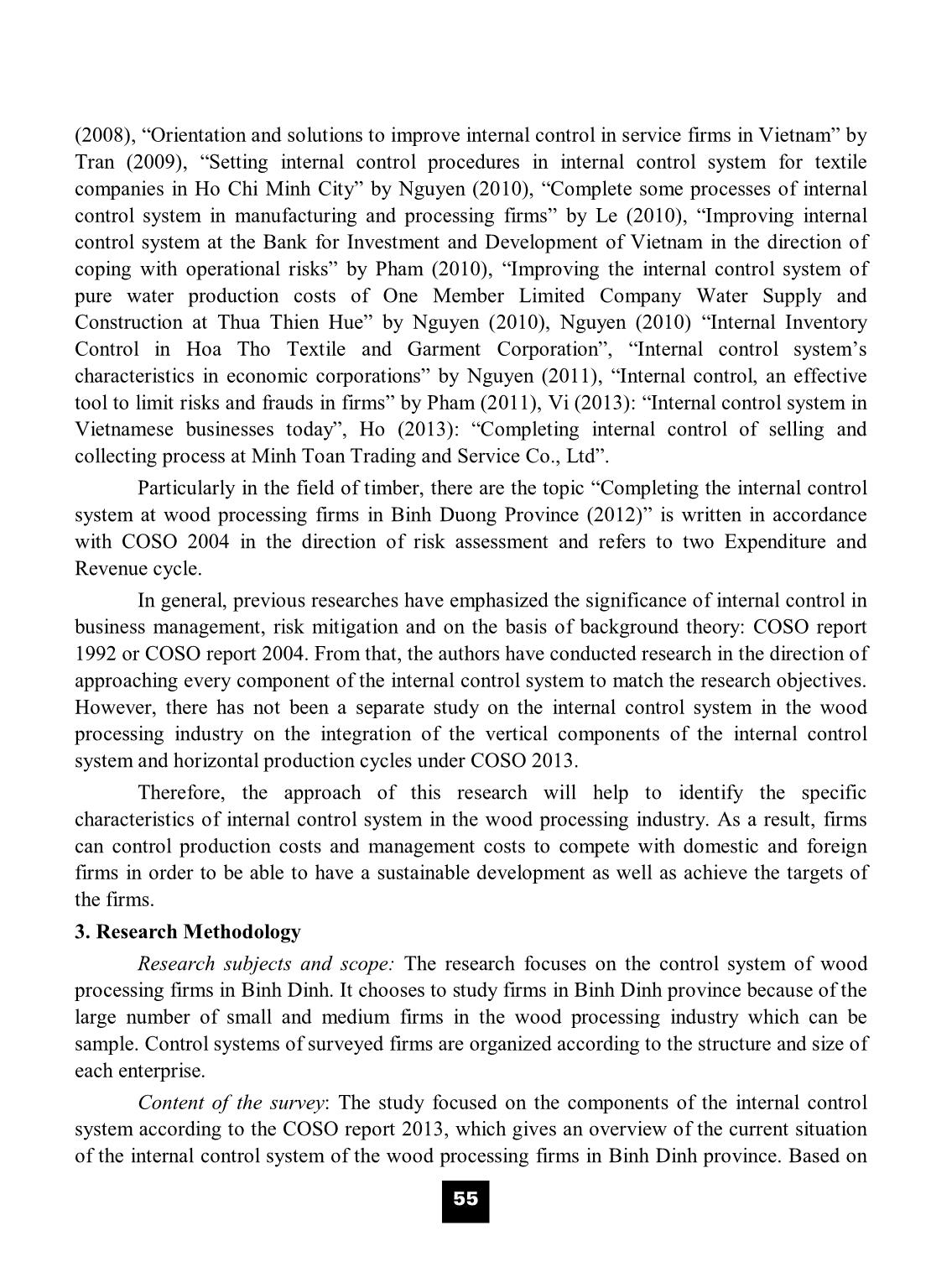
Trang 2
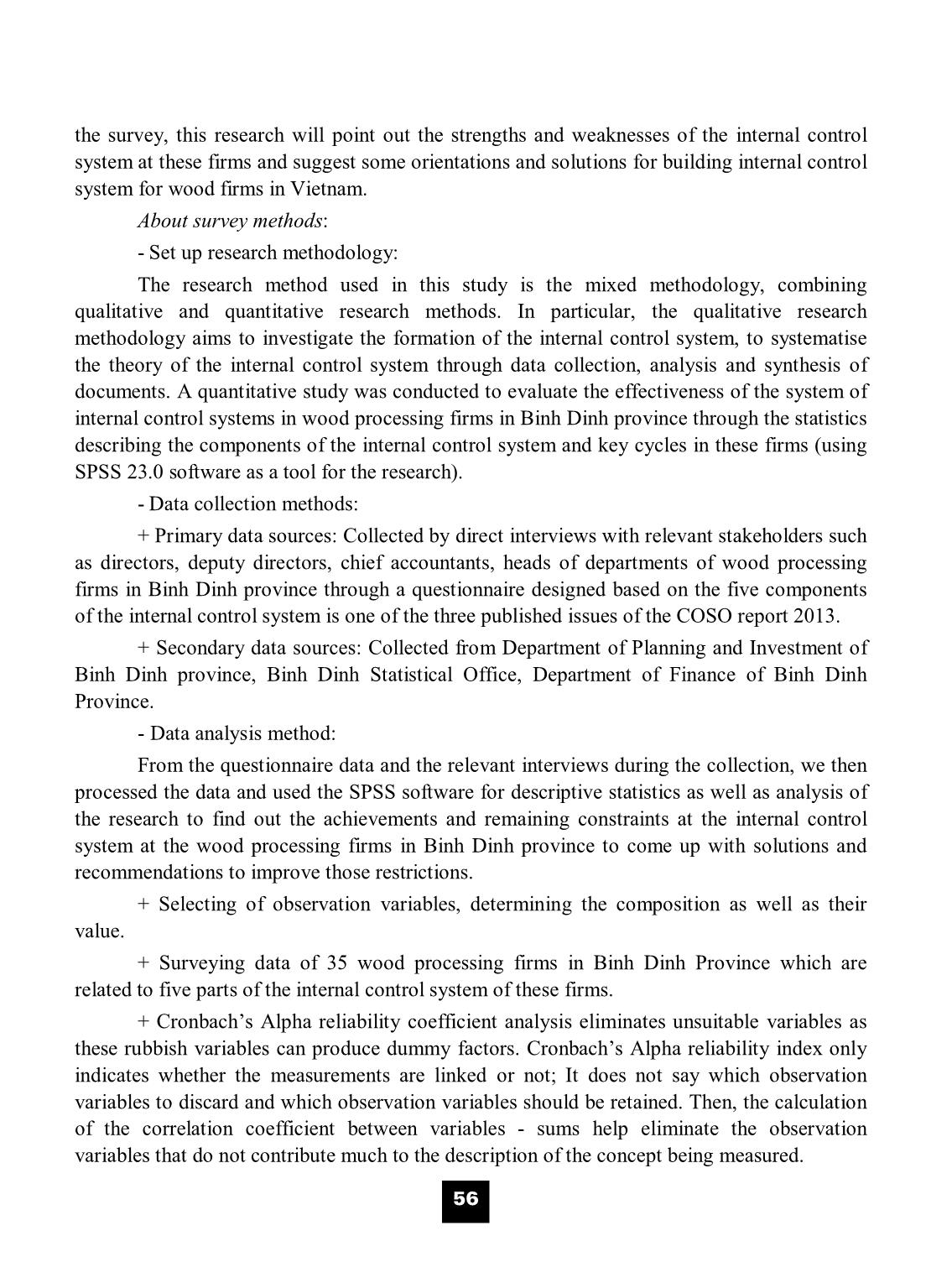
Trang 3
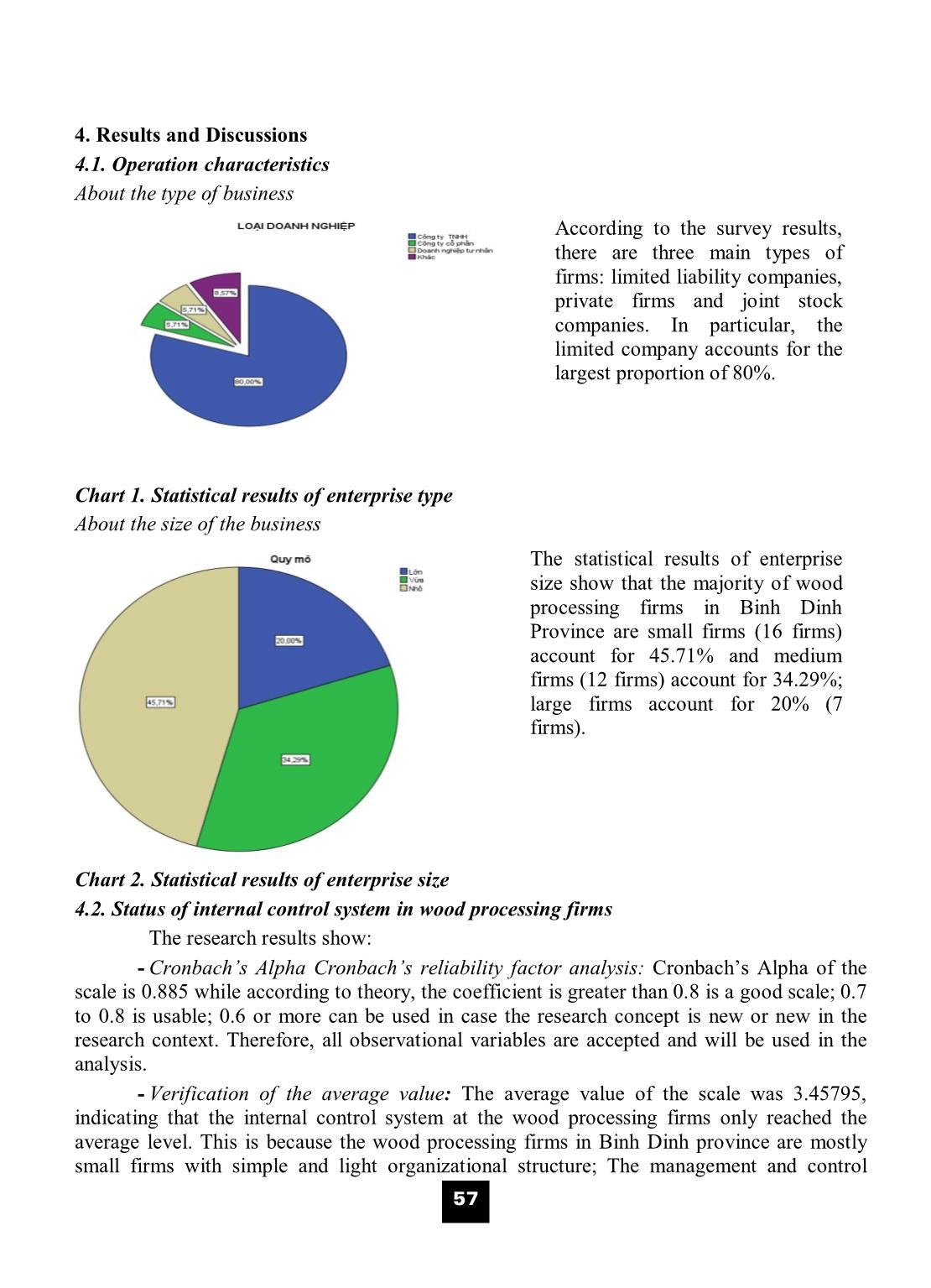
Trang 4
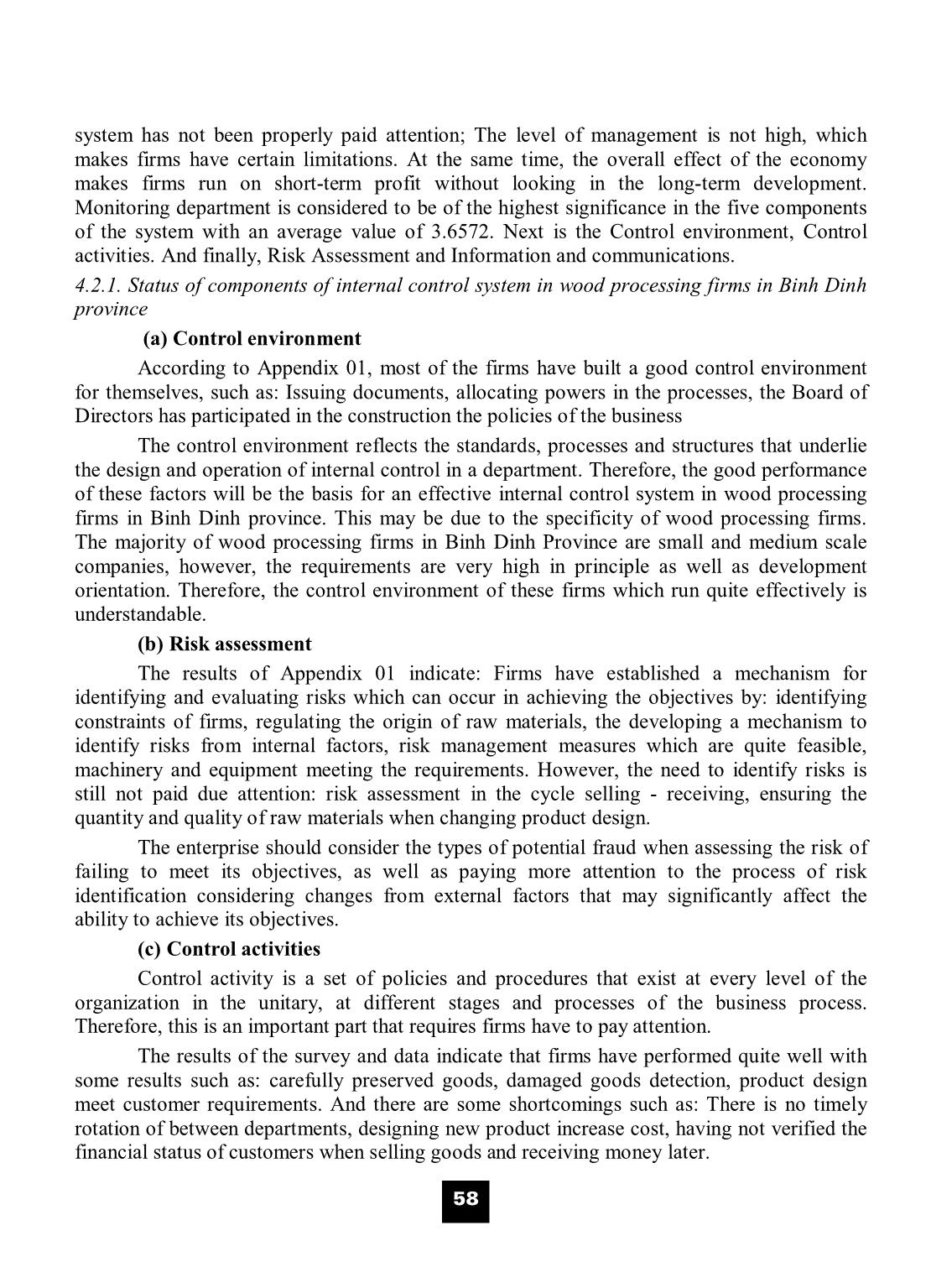
Trang 5
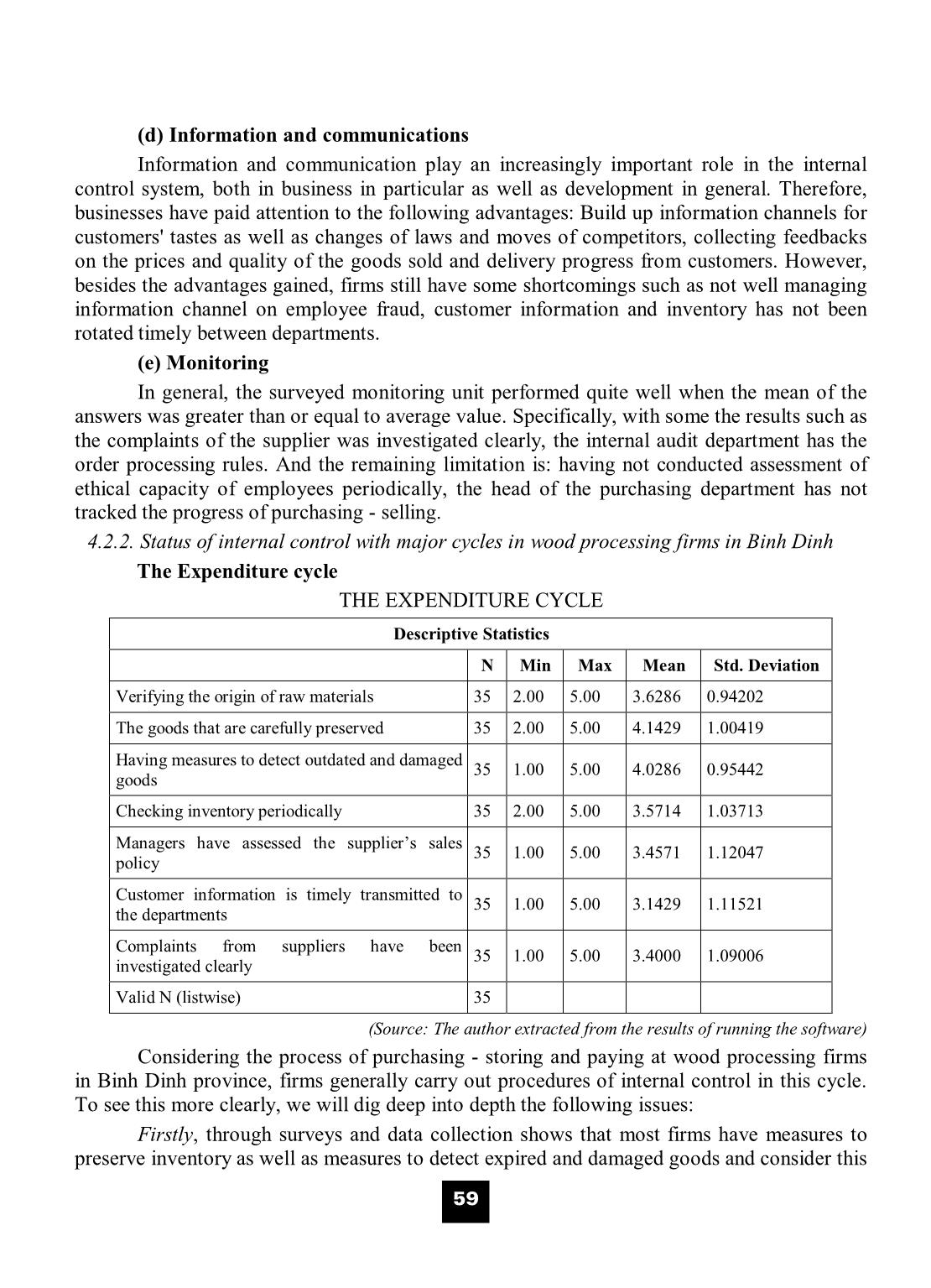
Trang 6
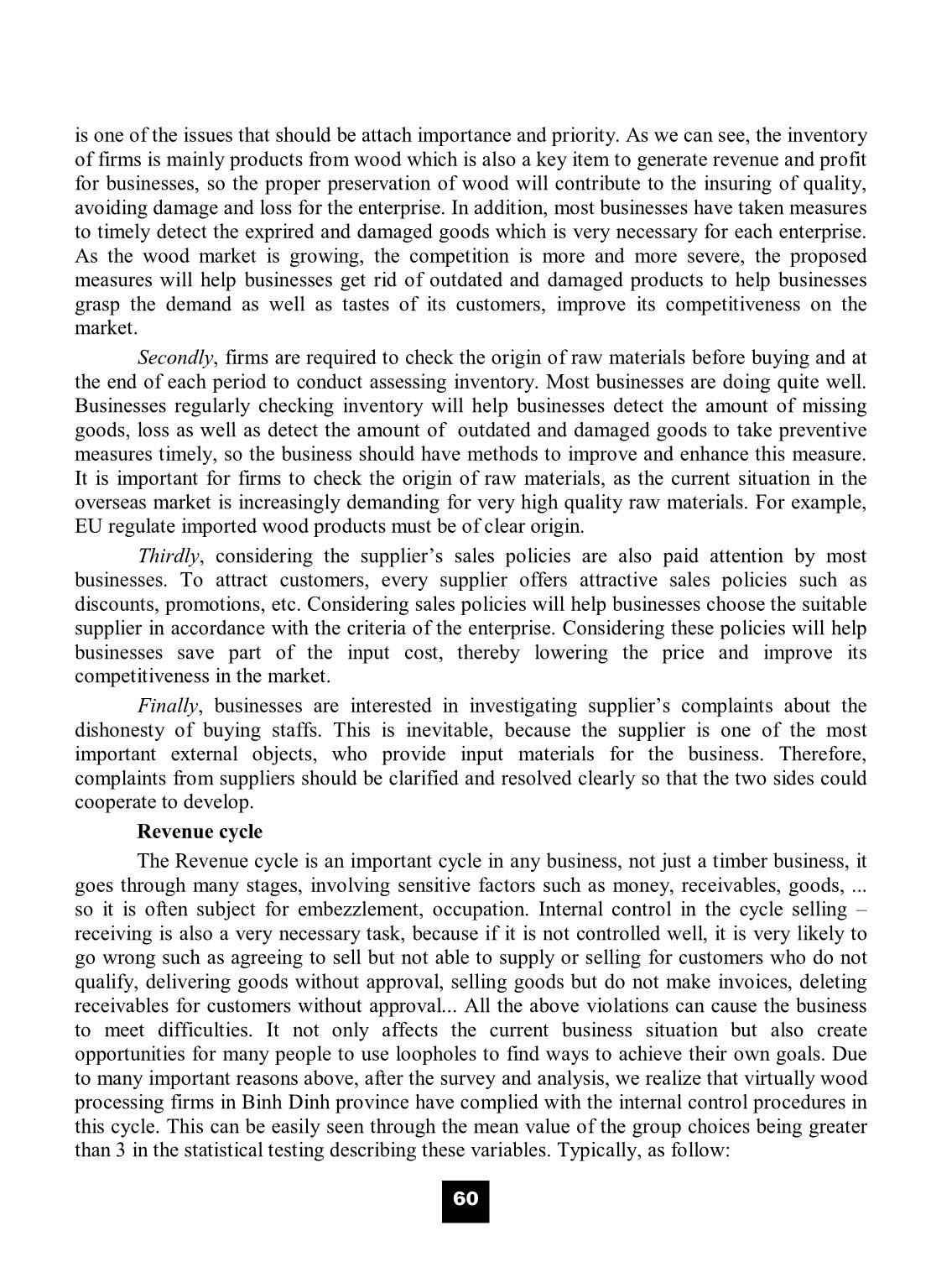
Trang 7
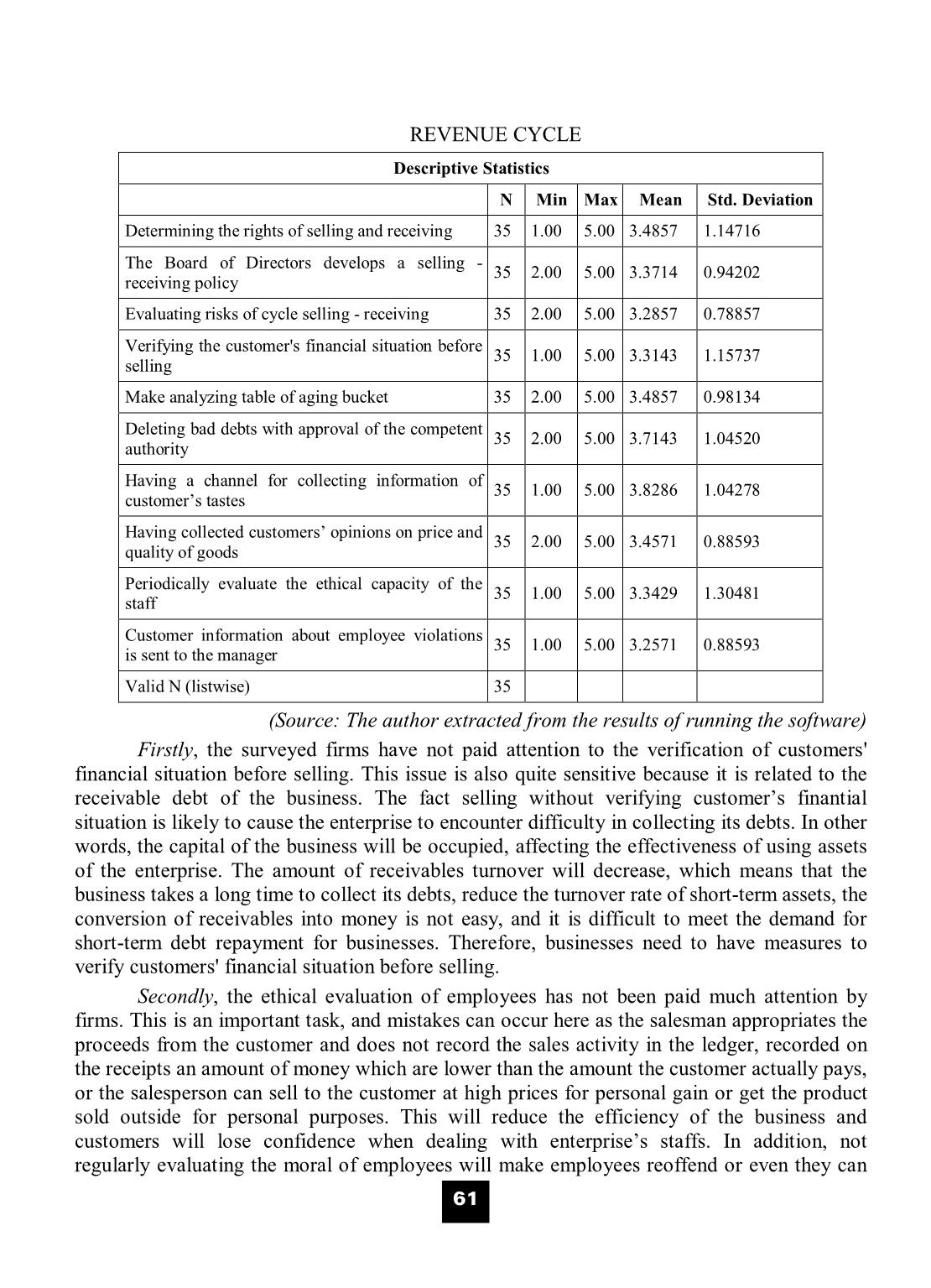
Trang 8
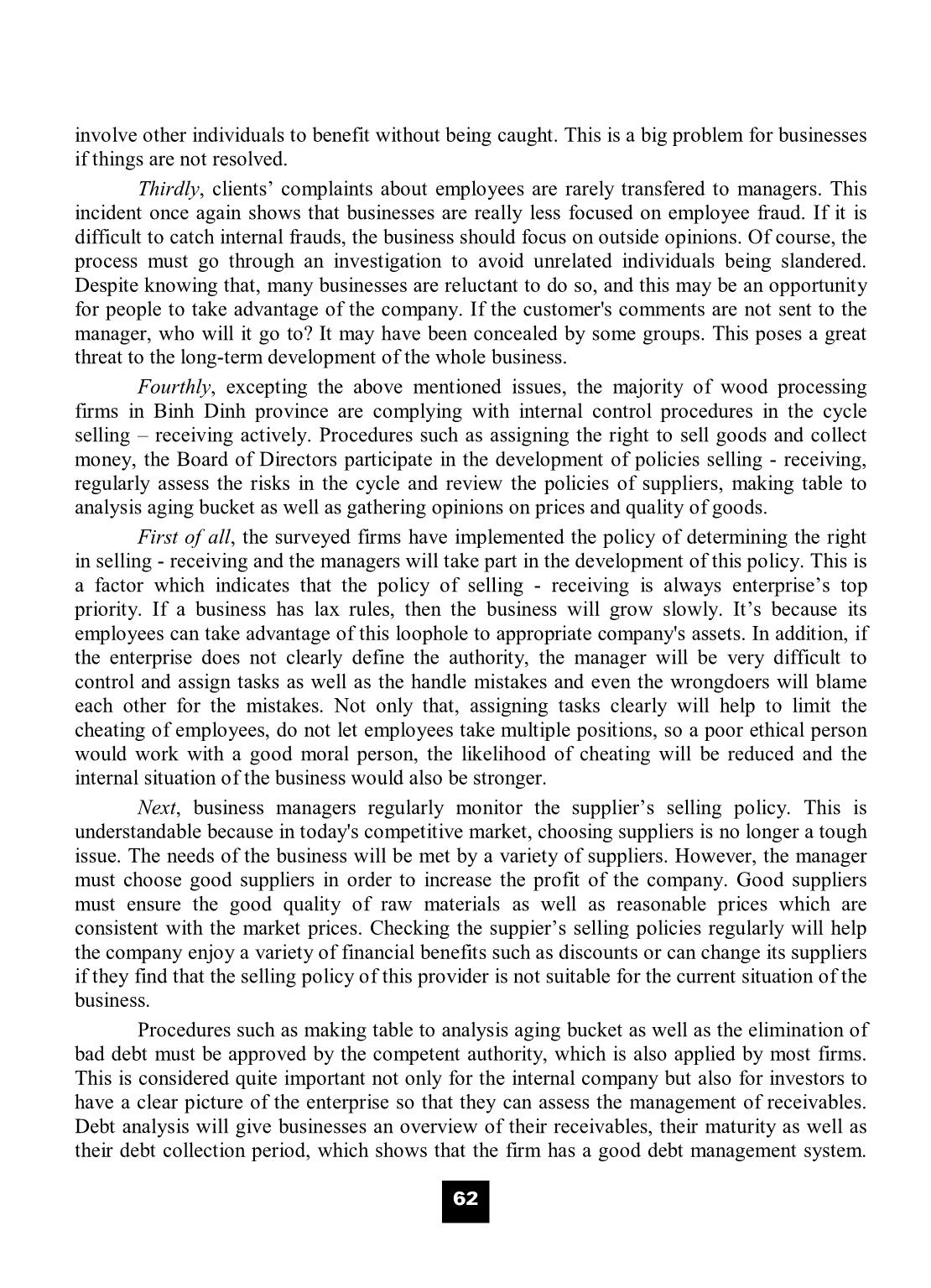
Trang 9
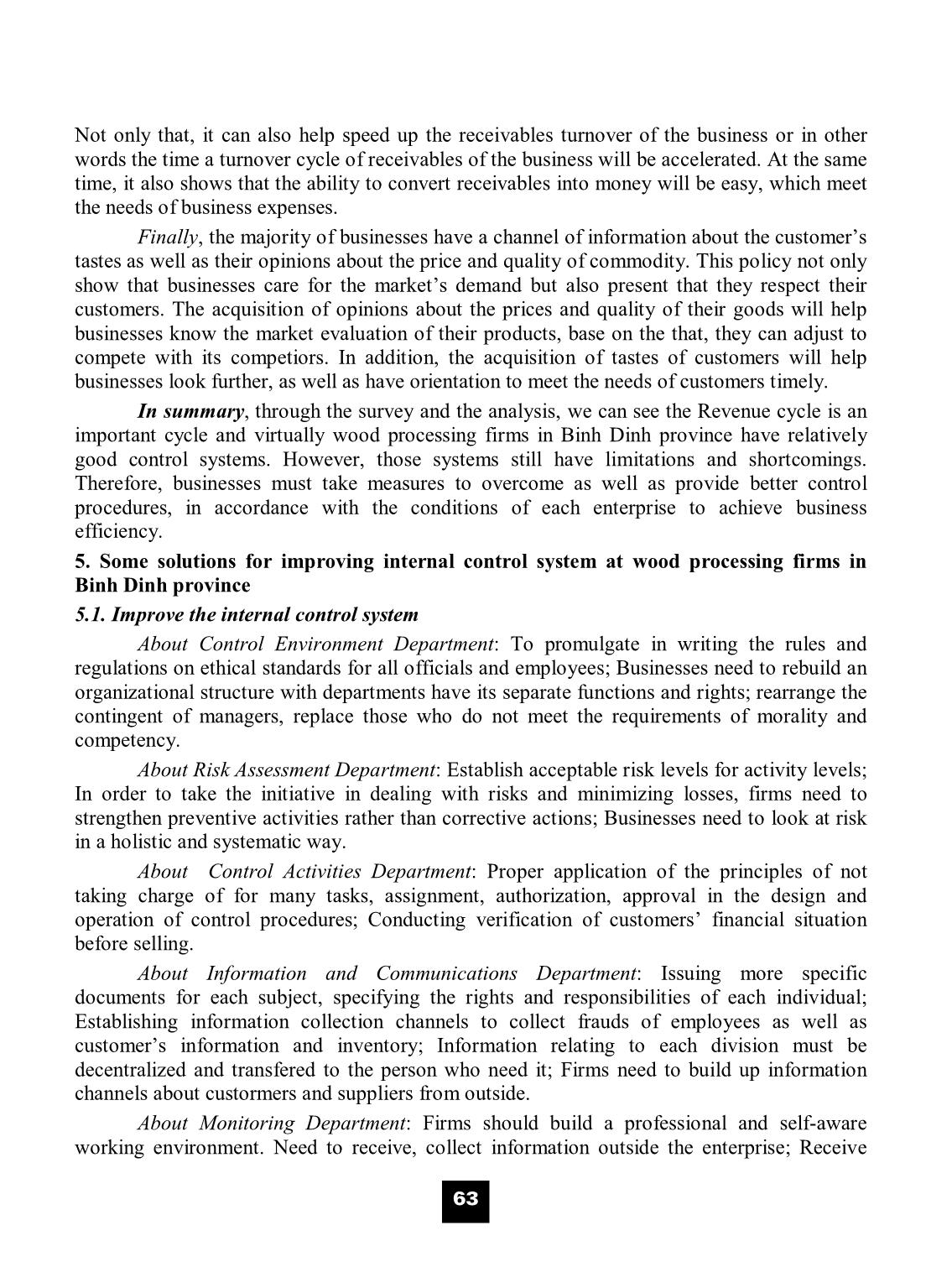
Trang 10
Tải về để xem bản đầy đủ
Bạn đang xem 10 trang mẫu của tài liệu "Improving internal control system of wood processing firms in Binh Dinh", để tải tài liệu gốc về máy hãy click vào nút Download ở trên
Tóm tắt nội dung tài liệu: Improving internal control system of wood processing firms in Binh Dinh
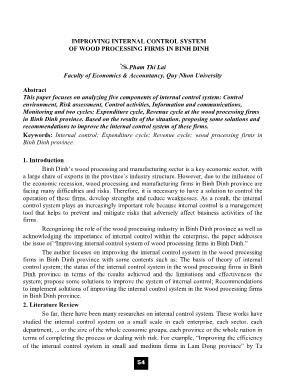
aw materials as well as reasonable prices which are consistent with the market prices. Checking the suppier’s selling policies regularly will help the company enjoy a variety of financial benefits such as discounts or can change its suppliers if they find that the selling policy of this provider is not suitable for the current situation of the business. Procedures such as making table to analysis aging bucket as well as the elimination of bad debt must be approved by the competent authority, which is also applied by most firms. This is considered quite important not only for the internal company but also for investors to have a clear picture of the enterprise so that they can assess the management of receivables. Debt analysis will give businesses an overview of their receivables, their maturity as well as their debt collection period, which shows that the firm has a good debt management system. n trÞ - Kinh nghiÖm quèc tÕ vµ thùc tr¹ng ë ViÖt Nam 63 Not only that, it can also help speed up the receivables turnover of the business or in other words the time a turnover cycle of receivables of the business will be accelerated. At the same time, it also shows that the ability to convert receivables into money will be easy, which meet the needs of business expenses. Finally, the majority of businesses have a channel of information about the customer’s tastes as well as their opinions about the price and quality of commodity. This policy not only show that businesses care for the market’s demand but also present that they respect their customers. The acquisition of opinions about the prices and quality of their goods will help businesses know the market evaluation of their products, base on the that, they can adjust to compete with its competiors. In addition, the acquisition of tastes of customers will help businesses look further, as well as have orientation to meet the needs of customers timely. In summary, through the survey and the analysis, we can see the Revenue cycle is an important cycle and virtually wood processing firms in Binh Dinh province have relatively good control systems. However, those systems still have limitations and shortcomings. Therefore, businesses must take measures to overcome as well as provide better control procedures, in accordance with the conditions of each enterprise to achieve business efficiency. 5. Some solutions for improving internal control system at wood processing firms in Binh Dinh province 5.1. Improve the internal control system About Control Environment Department: To promulgate in writing the rules and regulations on ethical standards for all officials and employees; Businesses need to rebuild an organizational structure with departments have its separate functions and rights; rearrange the contingent of managers, replace those who do not meet the requirements of morality and competency. About Risk Assessment Department: Establish acceptable risk levels for activity levels; In order to take the initiative in dealing with risks and minimizing losses, firms need to strengthen preventive activities rather than corrective actions; Businesses need to look at risk in a holistic and systematic way. About Control Activities Department: Proper application of the principles of not taking charge of for many tasks, assignment, authorization, approval in the design and operation of control procedures; Conducting verification of customers’ financial situation before selling. About Information and Communications Department: Issuing more specific documents for each subject, specifying the rights and responsibilities of each individual; Establishing information collection channels to collect frauds of employees as well as customer’s information and inventory; Information relating to each division must be decentralized and transfered to the person who need it; Firms need to build up information channels about custormers and suppliers from outside. About Monitoring Department: Firms should build a professional and self-aware working environment. Need to receive, collect information outside the enterprise; Receive n trÞ - Kinh nghiÖm quèc tÕ vµ thùc tr¹ng ë ViÖt Nam 64 feedback on defects of the internal control system during the seminars, trainings or monthly company briefings; Monthly, ask staff to report on the performance of their duties. 5.2. Main business cycle in the business About the Expenditure cycle: Firms need to find a reputable supplier to ensure the quality and quantity of input materials; Purchases may only be made upon presentation of an authorized purchase order; The assessment of the competency, ethics and experience of the staff in the buying – selling department should be paid attention. About the Revenue cycle: reasonable commitment on delivery schedule; Receive orders in accordance with terms and conditions; Apply policies of selling on credit and controlling the credit reasonably; Deliver accurate quantity and type of products to the right customers; Fully accounting and policies about selling by cash. 5.3. Implementation of solutions to improve the internal control system at wood processing firms in Binh Dinh Recommendations to the Goverment: The Government should stipulate shortly the procedures for registering the afforestation and shorten the registration time for firms wishing to invest in afforestation. In addition to providing loans for firms planted forests, the Government also needs to provide loans to wood processing firms; The government should soon establish an international furniture quality testing center in Vietnam; The State should enhance the role and functions of the Wood Processing Association. Recommendations to firms: develop strategies for sustainable development and consistently implement them; Develop a plan to restructure the company, rearrange production system effectively; implement new, advanced, suitable and proven management methods to replace existing family management methods; Expeditiously invest in renewing production technologies in order to reduce costs, lower production costs and raise competitiveness; Ensure the harmony of interests among firms, customers and partners; delivery high quality goods to customers timely and assure complying with signed contracts; Promote activities of research and development. 6. Conclusion Nowadays, with fierce competition in the market, recession pressure and economic difficulties, businesses are becoming more and more interested in building an internal control system to help the organization reduce damages and operate more efficiently. With some solutions to perfect the internal control system for companies in this article, hopefully together with the effort and the management of the Board of Directors and the commitment and the efforts of the whole employees, the efficiency of the internal control system bring to the business is higher. From that, contribute to emproving the efficiency of firms as well as the social welfare and promoting the economy. However, due to time constraints, the article focuses on researching and finding solutions to complete the internal control system for the company on the Expenditure cycle and the Revenue cycle, having not conducted research and provide solutions on other cycles of the businesses. n trÞ - Kinh nghiÖm quèc tÕ vµ thùc tr¹ng ë ViÖt Nam 65 Appendix 1: VALUABLES’ AVERAGE VALUES OF FIVE COMPONENTS OF INTERNAL CONTROL SYSTEMS IN WOOD PROCESSING FIRMS IN BINH DINH PROVINCE N Mean Std. Deviation Std. Error Mean (1) Control environment Issuing documents 35 3.6286 0.80753 0.13650 Determining rights in the cycle selling - receiving 35 3.4857 1.14716 0.19390 The Board of Directors have involved in development of policies in the business cycle 35 3.3714 0.94202 0.15923 Issue measures to prevent damaged products 35 3.8571 0.94380 0.15953 (2) Risk assessment Identify difficulties 35 3.5429 1.03875 0.17558 Determine the origin of raw materials 35 3.6286 0.94202 0.15923 Develop a risk identification mechanism from the factor 35 3.0571 0.72529 0.12260 Evaluate the risks of the cycle selling - receiving 35 3.2857 0.78857 0.13329 Whether risk management measures are feasible 35 3.4286 0.91670 0.15495 Machinery and equipment meet the requirements 35 3.3714 1.05957 0.17910 Product design has quality assurance 35 3.2571 1.33599 0.22582 (3) Control activities The goods are carefully preserved 35 4.1429 1.00419 0.16974 There is staff turnover 35 2.8857 1.10537 0.18684 New products increase metarial costs and labor costs 35 3.2286 1.33032 0.22486 There are measures to detect outdated and damaged product 35 4.0286 0.95442 0.16133 The product has the right design 35 4.0000 0.97014 0.16398 Verify the customer's financial situation before selling 35 3.3143 1.15737 0.19563 (4) Information and communications There is a channel for collecting information about employee fraud 35 3.1429 1.06116 0.17937 There is a channel for collecting information about customer tastes 35 3.8286 1.04278 0.17626 Customer information is timely transmitted to the departments 35 3.1429 1.11521 0.18851 Customer information about employee violations is sent to the managers 35 3.2571 0.88593 0.14975 Set up communication channels for everyone to report fraud such as mail, hotline 35 3.1714 1.09774 0.18555 Collecting opinions on price and quality of goods 35 3.4571 0.88593 0.14975 (5) Monitoring Head of buying department track the progress 35 3.1714 1.15008 0.19440 Periodically evaluate competency, ethics and experience of the employees 35 3.3429 1.30481 0.22055 Complaints from suppliers have been investigated clearly 35 3.4000 1.09006 0.18425 The internal audit department has orders processing regulations 35 3.4857 1.12122 0.18952 Firms have evaluated incomplete products at the end of each busisness period 35 3.4286 1.42014 0.24005 ------------------------------ References 1. Department of Accounting Information System, Faculty of Accounting - Auditing (2012), University of Economics of Ho Chi Minh City, Hệ thống thông tin kế toán_tập 1,2 và 3, Eastern Publishing House. n trÞ - Kinh nghiÖm quèc tÕ vµ thùc tr¹ng ë ViÖt Nam 66 2. Department of Auditing, Faculty of Accounting - Auditing, University of Economics, HCMC (2014), Kiểm toán, Economic Publishing House in Ho Chi Minh City. 3. Department of Auditing, Faculty of Accounting - Auditing, University of Economics, HCMC (2016), Kiểm soát nội bộ, Economic Publishing House in Ho Chi Minh City. 4. Ministry of Agriculture and Rural Development (2010), Báo cáo tổng hợp: Quy hoạch công nghiệp chế biến gỗ Việt Nam (đến năm 2015 và định hướng đến năm 2025). 5. Government (2009), Quy hoạch tổng thể phát triển kinh tế - xã hội tỉnh Bình Định đến năm 2020. 6. GTZ Project (8/2008), Báo cáo khảo sát thực trạng công nghiệp chế biến gỗ tỉnh Bình Định. 7. Dương Thị Ngọc Bích (2012), Hoàn thiện Hệ thống kiểm soát nội bộ tại các DN sản xuất, chế biến gỗ trên địa bàn tỉnh Bình Dương, University of Economics Ho Chi Minh City. 8. Nguyễn Thị Thu Hoài (2015), Hoàn thiện hệ thống kiểm soát nội bộ tại Công ty Cổ phần cấp nước Đồng Nai, Master thesis, Lac Hong University. 9. Nguyễn Thị Ngọc Hương (2010), Thiết lập các quy trình trong hệ thống kiểm soát nội bộ cho các công ty dệt may địa bàn thành phố Hồ Chí Minh, University of Economics Ho Chi Minh City. 10. Phan Ánh Hè (2009), “Thực trạng ngành công nghiệp chế biến gỗ Việt Nam và Giải pháp ứng phó với sự thay đổi của thị trường gỗ thế giới”, Journal of Economic Development, (No. 224, June 2009). 11. Department of Industry and Trade of Binh Dinh Province (2010), Chuyển đổi phát triển sản xuất đồ gỗ nội thất: Hướng đi đúng cho DN chế biến gỗ Bình Định, Newsletter No. 03/2010. 12. Phạm Thị Như Sương (2010), Hoàn thiện hệ thống kiểm soát nội bộ tại ngân hàng đầu tư và phát triển Việt Nam theo hướng đối phó rủi ro hoạt động, University of Economics Ho Chi Minh City. 13. Documents and information of wood processing firms in Binh Dinh province. 14. Nguyễn Đình Thọ (2011), Phương pháp nghiên cứu khoa học trong kinh doanh, Labor and Social Publishing House. 15. Đinh Thụy Ngân Trang (2007), Hoàn thiện Hệ thống kiểm soát nội bộ tại các DN sản xuất, chế biến, University of Economics Ho Chi Minh City. 16. Đỗ Huyền Trang (2012), Hoàn thiện phân tích hiệu quả kinh doanh trong các DN chế biến gỗ xuất khẩu khu vực Nam Trung Bộ, National Economics University, Hanoi. 17. Nguyễn Thị Kim Tuyến (2012), Hoàn thiện hệ thống kiểm soát nội bộ tại các DN chế biến xuất khẩu thủy sản ở tỉnh Bình Thuận, University of Economics Ho Chi Minh City. 18. People’s Committee of Binh Dinh Province (2010), Đề án phát triển hàng xuất khẩu Tỉnh Bình Định đến năm 2015, định hướng đến năm 2020. 19. People’s Committee of Binh Dinh Province (2012), Quyết định về việc điều chỉnh, bổ sung chính sách hỗ trợ DN, hợp tác xã, cơ sở sản xuất thuộc làng nghề thuộc địa bàn tỉnh tham dự hội chợ, triển lãm trong nước và nước ngoài. 20. People’s Committee of Binh Dinh Province, Binh Dinh Department of Industry and Trade 2011, Diễn đàn Lâm sản Việt Nam 2011 (Vietnam Forest Products Festival for the first time in Binh Dinh 2011). 21. Binh Dinh Provincial People’s Committee, Department of Industry and Trade - Binh Dinh Association of Producing, Importing and Exporting Timber and Forest Products (2011), Đề án phát triển sản phẩm gỗ nội thất tỉnh Bình Định đến năm 2015. 22. Lê Thị Như Vân, Hoàn thiện một số quy trình kiểm soát nội bộ tại các DN sản xuất, chế biến, University of Economics Ho Chi Minh City. 23. Black, J. (2010), The Rise, Fall and Fate of Principles Based Regulation. Working paper, London School of Economics. 24. Bentson, G.J., M.Bromwich, and A. Wagenhofer (2006). Principles – verus rules-based accounting standards: The FASB’s standard setting strategy. ABCUS 42 (2): 165 – 188. 25. Committee of Sponsoring Organizations (1992), Internal Control: Integrated Framework (Executive Summary, Framwork, Reporting to External Parties, Addendum to Reporting to External Parties) 26. DeFelice, A.2010. Cloud: What Accountants Need to Know. At 27. Enterprise Risk Management – Intergrated Framework (2004) 28. Internal Auditor’s Manual and Guide – Milton Stevens Fonorow 29. Janvrin, Diane J., Payna, Elizabeth A., Byrnes Paul., Schneider, Gary P., and Curtis, Mary B. (2012), Journal Of Information Sytems 26 (2): 189-213 30. Marshall B.Romney, 1999, Accounting information systems, Prentice Hall, Upper Saddle River, New Jersey 07458. 31. Ren, K., C. Wang, and Q. Wang (2012). Security challenger for the public cloud. IEEE Internet Computing 16 (1): 69-73. ------------------------------
File đính kèm:
 improving_internal_control_system_of_wood_processing_firms_i.pdf
improving_internal_control_system_of_wood_processing_firms_i.pdf

